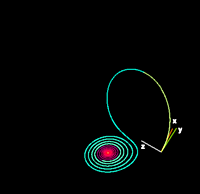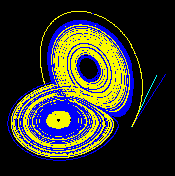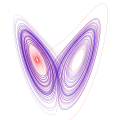Top Qs
Timeline
Chat
Perspective
Lorenz system
Chaotic model of atmospheric convection From Wikipedia, the free encyclopedia
Remove ads
The Lorenz system is a three-dimensional classical dynamic system represented by three ordinary differential equations . It was first developed by the meteorologist Edward Lorenz and describes chaotic behavior of fluid movement when subjected to heating.
This article may be too technical for most readers to understand. (December 2023) |
It has been suggested that this article be split out into articles titled Lorenz system and Lorenz attractor. (Discuss) (November 2025) |

Although the Lorenz system is deterministic, its dynamics depend on the choice of initial parameters. For some ranges of parameters, the system is predictable as trajectories settle into fixed points or simple periodic orbits. In contrast, for other parameter ranges, the system becomes chaotic and the solutions never settle down but instead trace out the butterfly-shaped Lorenz attractor, popularly known as butterfly effect. In this regime, small differences in initial conditions grows exponentially making long-term prediction practically impossible.
Remove ads
Overview
Summarize
Perspective
Edward Lorenz developed the Lorenz system as a simplified mathematical model to understand atmospheric convection.[1] The model describes how the three factors, the intensity of the convection (x), the temperature difference between the rising and falling air currents (y), and the distortion of the vertical temperature profile from a linear (z) changes over time.
The model was developed with the assistance of Ellen Fetter and Margaret Hamilton. Ellen Fetter performed the numerical simulations and created figures, while Margaret Hamilton helped with initial computations.,[1][2] The behavior of the system was found to be governed by the following equations:
The constants σ, ρ, and β are parameters representing physical properties of the system. σ here is known as Prandtl number, ρ is the Rayleigh number, and β relates to the physical dimensions of the fluid layer.[3]
From a technical standpoint, the Lorenz system is nonlinear, aperiodic, three-dimensional, and deterministic. The Lorenz equations have been found to model behavior in a wide variety of systems, including lasers,[4] dynamos,[5] electric circuits,[6] and even some chemical reactions.[7][3]
Remove ads
Analysis
Summarize
Perspective
One normally assumes that the parameters σ, ρ, and β are positive. Lorenz used the values σ = 10, ρ = 28, and β = 8/3. The system exhibits chaotic behavior for these (and nearby) values.[8]
If ρ < 1 then there is only one equilibrium point, which is at the origin. This point corresponds to no convection. All orbits converge to the origin, which is a global attractor, when ρ < 1.[9]
A pitchfork bifurcation occurs at ρ = 1, and for ρ > 1 two additional critical points appear at These correspond to steady convection. This pair of equilibrium points is stable only if
which can hold only for positive ρ if σ > β + 1. At the critical value, both equilibrium points lose stability through a subcritical Hopf bifurcation.[10]
When ρ = 28, σ = 10, and β = 8/3, the Lorenz system has chaotic solutions (but not all solutions are chaotic). Almost all initial points will tend to an invariant set – the Lorenz attractor – a strange attractor, a fractal, and a self-excited attractor with respect to all three equilibria. Its Hausdorff dimension is estimated from above by the Lyapunov dimension (Kaplan-Yorke dimension) as 2.06±0.01,[11] and the correlation dimension is estimated to be 2.05±0.01.[12] The exact Lyapunov dimension formula of the global attractor can be found analytically under classical restrictions on the parameters:[13][11][14]
The Lorenz attractor is difficult to analyze, but the action of the differential equation on the attractor is described by a fairly simple geometric model.[15] Proving that this is indeed the case is the fourteenth problem on the list of Smale's problems. This problem was the first one to be resolved, by Warwick Tucker in 2002.[16]
For other values of ρ, the system displays knotted periodic orbits. For example, with ρ = 99.96 it becomes a T(3,2) torus knot.
Remove ads
Connection to the Tent map

In Figure 4 of his paper,[1] Lorenz plotted the relative maximum value in the z direction achieved by the system against the previous relative maximum in the z direction. This procedure later became known as a Lorenz map (not to be confused with a Poincaré plot, which plots the intersections of a trajectory with a prescribed surface). The resulting plot has a shape very similar to the tent map. Lorenz also found that when the maximum z value is above a certain cut-off, the system will switch to the next lobe. Combining this with the chaos known to be exhibited by the tent map, he showed that the system switches between the two lobes chaotically.
Simulations
Summarize
Perspective


Julia simulation
using Plots
# define the Lorenz attractor
@kwdef mutable struct Lorenz
dt::Float64 = 0.02
σ::Float64 = 10
ρ::Float64 = 28
β::Float64 = 8/3
x::Float64 = 2
y::Float64 = 1
z::Float64 = 1
end
function step!(l::Lorenz)
dx = l.σ * (l.y - l.x)
dy = l.x * (l.ρ - l.z) - l.y
dz = l.x * l.y - l.β * l.z
l.x += l.dt * dx
l.y += l.dt * dy
l.z += l.dt * dz
end
attractor = Lorenz()
# initialize a 3D plot with 1 empty series
plt = plot3d(
1,
xlim = (-30, 30),
ylim = (-30, 30),
zlim = (0, 60),
title = "Lorenz Attractor",
marker = 2,
)
# build an animated gif by pushing new points to the plot, saving every 10th frame
@gif for i=1:1500
step!(attractor)
push!(plt, attractor.x, attractor.y, attractor.z)
end every 10
Maple simulation
deq := [diff(x(t), t) = 10*(y(t) - x(t)), diff(y(t), t) = 28*x(t) - y(t) - x(t)*z(t), diff(z(t), t) = x(t)*y(t) - 8/3*z(t)]:
with(DEtools):
DEplot3d(deq, {x(t), y(t), z(t)}, t = 0 .. 100, [[x(0) = 10, y(0) = 10, z(0) = 10]], stepsize = 0.01, x = -20 .. 20, y = -25 .. 25, z = 0 .. 50, linecolour = sin(t*Pi/3), thickness = 1, orientation = [-40, 80], title = `Lorenz Chaotic Attractor`);
Maxima simulation
[sigma, rho, beta]: [10, 28, 8/3]$
eq: [sigma*(y-x), x*(rho-z)-y, x*y-beta*z]$
sol: rk(eq, [x, y, z], [1, 0, 0], [t, 0, 50, 1/100])$
len: length(sol)$
x: makelist(sol[k][2], k, len)$
y: makelist(sol[k][3], k, len)$
z: makelist(sol[k][4], k, len)$
draw3d(points_joined=true, point_type=-1, points(x, y, z), proportional_axes=xyz)$
MATLAB simulation
% Solve over time interval [0,100] with initial conditions [1,1,1]
% ''f'' is set of differential equations
% ''a'' is array containing x, y, and z variables
% ''t'' is time variable
sigma = 10;
beta = 8/3;
rho = 28;
f = @(t,a) [-sigma*a(1) + sigma*a(2); rho*a(1) - a(2) - a(1)*a(3); -beta*a(3) + a(1)*a(2)];
[t,a] = ode45(f,[0 100],[1 1 1]); % Runge-Kutta 4th/5th order ODE solver
plot3(a(:,1),a(:,2),a(:,3))
Mathematica simulation
Standard way:
tend = 50;
eq = {x'[t] == σ (y[t] - x[t]),
y'[t] == x[t] (ρ - z[t]) - y[t],
z'[t] == x[t] y[t] - β z[t]};
init = {x[0] == 10, y[0] == 10, z[0] == 10};
pars = {σ->10, ρ->28, β->8/3};
{xs, ys, zs} =
NDSolveValue[{eq /. pars, init}, {x, y, z}, {t, 0, tend}];
ParametricPlot3D[{xs[t], ys[t], zs[t]}, {t, 0, tend}]
Less verbose:
lorenz = NonlinearStateSpaceModel[{{σ (y - x), x (ρ - z) - y, x y - β z}, {}}, {x, y, z}, {σ, ρ, β}];
soln[t_] = StateResponse[{lorenz, {10, 10, 10}}, {10, 28, 8/3}, {t, 0, 50}];
ParametricPlot3D[soln[t], {t, 0, 50}]
R simulation
library(deSolve)
library(plotly)
# parameters
prm <- list(sigma = 10, rho = 28, beta = 8/3)
# initial values
varini <- c(
X = 1,
Y = 1,
Z = 1
)
Lorenz <- function (t, vars, prm) {
with(as.list(vars), {
dX <- prm$sigma*(Y - X)
dY <- X*(prm$rho - Z) - Y
dZ <- X*Y - prm$beta*Z
return(list(c(dX, dY, dZ)))
})
}
times <- seq(from = 0, to = 100, by = 0.01)
# call ode solver
out <- ode(y = varini, times = times, func = Lorenz,
parms = prm)
# to assign color to points
gfill <- function (repArr, long) {
rep(repArr, ceiling(long/length(repArr)))[1:long]
}
dout <- as.data.frame(out)
dout$color <- gfill(rainbow(10), nrow(dout))
# Graphics production with Plotly:
plot_ly(
data=dout, x = ~X, y = ~Y, z = ~Z,
type = 'scatter3d', mode = 'lines',
opacity = 1, line = list(width = 6, color = ~color, reverscale = FALSE)
)





SageMath simulation
We try to solve this system of equations for , , , with initial conditions , , .
# we solve the Lorenz system of the differential equations.
# Runge-Kutta's method y_{n+1}= y_n + h*(k_1 + 2*k_2+2*k_3+k_4)/6; x_{n+1}=x_n+h
# k_1=f(x_n,y_n), k_2=f(x_n+h/2, y_n+hk_1/2), k_3=f(x_n+h/2, y_n+hk_2/2), k_4=f(x_n+h, y_n+hk_3)
# differential equation
def Runge_Kutta(f,v,a,b,h,n):
tlist = [a+i*h for i in range(n+1)]
y = [[0,0,0] for _ in range(n+1)]
# Taking length of f (number of equations).
m=len(f)
# Number of variables in v.
vm=len(v)
if m!=vm:
return("error, number of equations is not equal with the number of variables.")
for r in range(vm):
y[0][r]=b[r]
# making a vector and component will be a list
# main part of the algorithm
k1=[0 for _ in range(m)]
k2=[0 for _ in range(m)]
k3=[0 for _ in range(m)]
k4=[0 for _ in range(m)]
for i in range(1,n+1): # for each t_i, i=1, ... , n
# k1=h*f(t_{i-1},x_1(t_{i-1}),...,x_m(t_{i-1}))
for j in range(m): # for each f_{j+1}, j=0, ... , m-1
k1[j]=f[j].subs(t==tlist[i-1])
for r in range(vm):
k1[j]=k1[j].subs(v[r]==y[i-1][r])
k1[j]=h*k1[j]
for j in range(m): # k2=h*f(t_{i-1}+h/2,x_1(t_{i-1})+k1/2,...,x_m(t_{i-1}+k1/2))
k2[j]=f[j].subs(t==tlist[i-1]+h/2)
for r in range(vm):
k2[j]=k2[j].subs(v[r]==y[i-1][r]+k1[r]/2)
k2[j]=h*k2[j]
for j in range(m): # k3=h*f(t_{i-1}+h/2,x_1(t_{i-1})+k2/2,...,x_m(t_{i-1})+k2/2)
k3[j]=f[j].subs(t==tlist[i-1]+h/2)
for r in range(vm):
k3[j]=k3[j].subs(v[r]==y[i-1][r]+k2[r]/2)
k3[j]=h*k3[j]
for j in range(m): # k4=h*f(t_{i-1}+h,x_1(t_{i-1})+k3,...,x_m(t_{i-1})+k3)
k4[j]=f[j].subs(t==tlist[i-1]+h)
for r in range(vm):
k4[j]=k4[j].subs(v[r]==y[i-1][r]+k3[r])
k4[j]=h*k4[j]
for j in range(m): # Now x_j(t_i)=x_j(t_{i-1})+(k1+2k2+2k3+k4)/6
y[i][j]=y[i-1][j]+(k1[j]+2*k2[j]+2*k3[j]+k4[j])/6
return(tlist,y)
# (Figure 1) Here, we plot the solutions of the Lorenz ODE system.
a=0.0 # t_0
b=[0.0,.50,0.0] # x_1(t_0), ... , x_m(t_0)
t=var('t')
x = var('x', n=3, latex_name='x')
v=[x[ii] for ii in range(3)]
f= [10*(x1-x0),x0*(28-x2)-x1,x0*x1-(8/3)*x2];
n=1600
h=0.0125
tlist,y=Runge_Kutta(f,v,a,b,h,n)
#print(tlist)
#print(y)
T=point3d([[y[i][0],y[i][1],y[i][2]] for i in range(n)], color='red')
S=line3d([[y[i][0],y[i][1],y[i][2]] for i in range(n)], color='red')
show(T+S)
# (Figure 2) Here, we plot every y1, y2, and y3 in terms of time.
a=0.0 # t_0
b=[0.0,.50,0.0] # x_1(t_0), ... , x_m(t_0)
t=var('t')
x = var('x', n=3, latex_name='x')
v=[x[ii] for ii in range(3)]
Lorenz= [10*(x1-x0),x0*(28-x2)-x1,x0*x1-(8/3)*x2];
n=100
h=0.1
tlist,y=Runge_Kutta(Lorenz,v,a,b,h,n)
#Runge_Kutta(f,v,0,b,h,n)
#print(tlist)
#print(y)
P1=list_plot([[tlist[i],y[i][0]] for i in range(n)], plotjoined=True, color='red');
P2=list_plot([[tlist[i],y[i][1]] for i in range(n)], plotjoined=True, color='green');
P3=list_plot([[tlist[i],y[i][2]] for i in range(n)], plotjoined=True, color='yellow');
show(P1+P2+P3)
# (Figure 3) Here, we plot the y and x or equivalently y2 and y1
a=0.0 # t_0
b=[0.0,.50,0.0] # x_1(t_0), ... , x_m(t_0)
t=var('t')
x = var('x', n=3, latex_name='x')
v=[x[ii] for ii in range(3)]
f= [10*(x1-x0),x0*(28-x2)-x1,x0*x1-(8/3)*x2];
n=800
h=0.025
tlist,y=Runge_Kutta(f,v,a,b,h,n)
vv=[[y[i][0],y[i][1]] for i in range(n)];
#print(tlist)
#print(y)
T=points(vv, rgbcolor=(0.2,0.6, 0.1), pointsize=10)
S=line(vv,rgbcolor=(0.2,0.6, 0.1))
show(T+S)
# (Figure 4) Here, we plot the z and x or equivalently y3 and y1
a=0.0 # t_0
b=[0.0,.50,0.0] # x_1(t_0), ... , x_m(t_0)
t=var('t')
x = var('x', n=3, latex_name='x')
v=[x[ii] for ii in range(3)]
f= [10*(x1-x0),x0*(28-x2)-x1,x0*x1-(8/3)*x2];
n=800
h=0.025
tlist,y=Runge_Kutta(f,v,a,b,h,n)
vv=[[y[i][0],y[i][2]] for i in range(n)];
#print(tlist)
#print(y)
T=points(vv, rgbcolor=(0.2,0.6, 0.1), pointsize=10)
S=line(vv,rgbcolor=(0.2,0.6, 0.1))
show(T+S)
# (Figure 5) Here, we plot the z and x or equivalently y3 and y2
a=0.0 # t_0
b=[0.0,.50,0.0] # x_1(t_0), ... , x_m(t_0)
t=var('t')
x = var('x', n=3, latex_name='x')
v=[x[ii] for ii in range(3)]
f= [10*(x1-x0),x0*(28-x2)-x1,x0*x1-(8/3)*x2];
n=800
h=0.025
tlist,y=Runge_Kutta(f,v,a,b,h,n)
vv=[[y[i][1],y[i][2]] for i in range(n)];
#print(tlist)
#print(y)
T=points(vv, rgbcolor=(0.2,0.6, 0.1), pointsize=10)
S=line(vv,rgbcolor=(0.2,0.6, 0.1))
show(T+S)
Remove ads
Applications
Summarize
Perspective
Model for atmospheric convection
As shown in Lorenz's original paper,[17] the Lorenz system is a reduced version of a larger system studied earlier by Barry Saltzman.[18] The Lorenz equations are derived from the Oberbeck–Boussinesq approximation to the equations describing fluid circulation in a shallow layer of fluid, heated uniformly from below and cooled uniformly from above.[19] This fluid circulation is known as Rayleigh–Bénard convection. The fluid is assumed to circulate in two dimensions (vertical and horizontal) with periodic rectangular boundary conditions.[20]
The partial differential equations modeling the system's stream function and temperature are subjected to a spectral Galerkin approximation: the hydrodynamic fields are expanded in Fourier series, which are then severely truncated to a single term for the stream function and two terms for the temperature. This reduces the model equations to a set of three coupled, nonlinear ordinary differential equations. A detailed derivation may be found, for example, in nonlinear dynamics texts from Hilborn (2000), Appendix C; Bergé, Pomeau & Vidal (1984), Appendix D; or Shen (2016),[21] Supplementary Materials.
Model for the nature of chaos and order in the atmosphere
The scientific community accepts that the chaotic features found in low-dimensional Lorenz models could represent features of the Earth's atmosphere,[22][23][24] yielding the statement of “weather is chaotic.” By comparison, based on the concept of attractor coexistence within the generalized Lorenz model[25] and the original Lorenz model,[26][27] Shen and his co-authors proposed a revised view that “weather possesses both chaos and order with distinct predictability”.[24][28] The revised view, which is a build-up of the conventional view, is used to suggest that “the chaotic and regular features found in theoretical Lorenz models could better represent features of the Earth's atmosphere”.
Resolution of Smale's 14th problem
Smale's 14th problem asks, "Do the properties of the Lorenz attractor exhibit that of a strange attractor?". The problem was answered affirmatively by Warwick Tucker in 2002.[16] To prove this result, Tucker used rigorous numerics methods like interval arithmetic and normal forms. First, Tucker defined a cross section that is cut transversely by the flow trajectories. From this, one can define the first-return map , which assigns to each the point where the trajectory of first intersects .
Then the proof is split in three main points that are proved and imply the existence of a strange attractor.[29] The three points are:
- There exists a region invariant under the first-return map, meaning .
- The return map admits a forward invariant cone field.
- Vectors inside this invariant cone field are uniformly expanded by the derivative of the return map.
To prove the first point, we notice that the cross section is cut by two arcs formed by .[29] Tucker covers the location of these two arcs by small rectangles , the union of these rectangles gives . Now, the goal is to prove that for all points in , the flow will bring back the points in , in . To do that, we take a plan below at a distance small, then by taking the center of and using Euler integration method, one can estimate where the flow will bring in which gives us a new point . Then, one can estimate where the points in will be mapped in using Taylor expansion, this gives us a new rectangle centered on . Thus we know that all points in will be mapped in . The goal is to do this method recursively until the flow comes back to and we obtain a rectangle in such that we know that . The problem is that our estimation may become imprecise after several iterations, thus what Tucker does is to split into smaller rectangles and then apply the process recursively. Another problem is that as we are applying this algorithm, the flow becomes more 'horizontal',[29] leading to a dramatic increase in imprecision. To prevent this, the algorithm changes the orientation of the cross sections, becoming either horizontal or vertical.
Remove ads
Gallery
- A solution in the Lorenz attractor plotted at high resolution in the xz plane.
- A solution in the Lorenz attractor rendered as an SVG.
- An animation showing trajectories of multiple solutions in a Lorenz system.
- A solution in the Lorenz attractor rendered as a metal wire to show direction and 3D structure.
- An animation showing the divergence of nearby solutions to the Lorenz system.
- A visualization of the Lorenz attractor near an intermittent cycle.
- Two streamlines in a Lorenz system, from ρ = 0 to ρ = 28 (σ = 10, β = 8/3).
- Animation of a Lorenz System with rho-dependence.
- Animation of the Lorenz attractor in the Brain Dynamics Toolbox.[30]
Remove ads
See also
- Eden's conjecture on the Lyapunov dimension
- Lorenz 96 model
- List of chaotic maps
- Takens' theorem
Notes
References
Further reading
External links
Wikiwand - on
Seamless Wikipedia browsing. On steroids.
Remove ads

![{\displaystyle {\begin{aligned}{\frac {\mathrm {d} x}{\mathrm {d} t}}&=\sigma (y-x),\\[6pt]{\frac {\mathrm {d} y}{\mathrm {d} t}}&=x(\rho -z)-y,\\[6pt]{\frac {\mathrm {d} z}{\mathrm {d} t}}&=xy-\beta z.\end{aligned}}}](http://wikimedia.org/api/rest_v1/media/math/render/svg/7928004d58943529a7be774575a62ca436a82a7f)










 ...
...







































